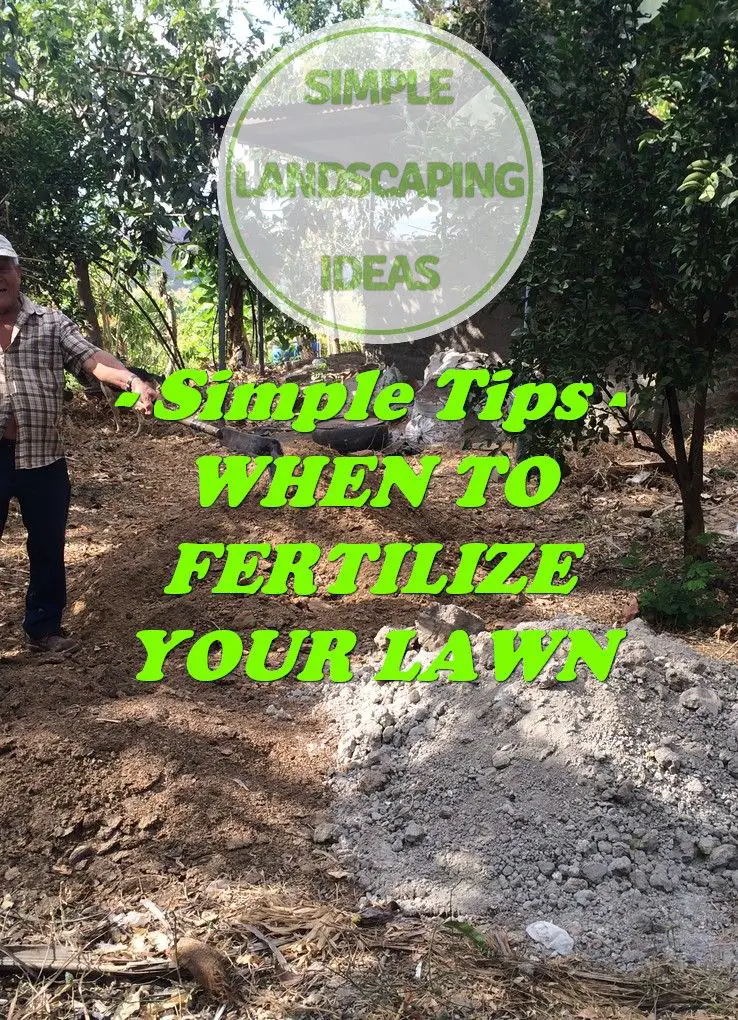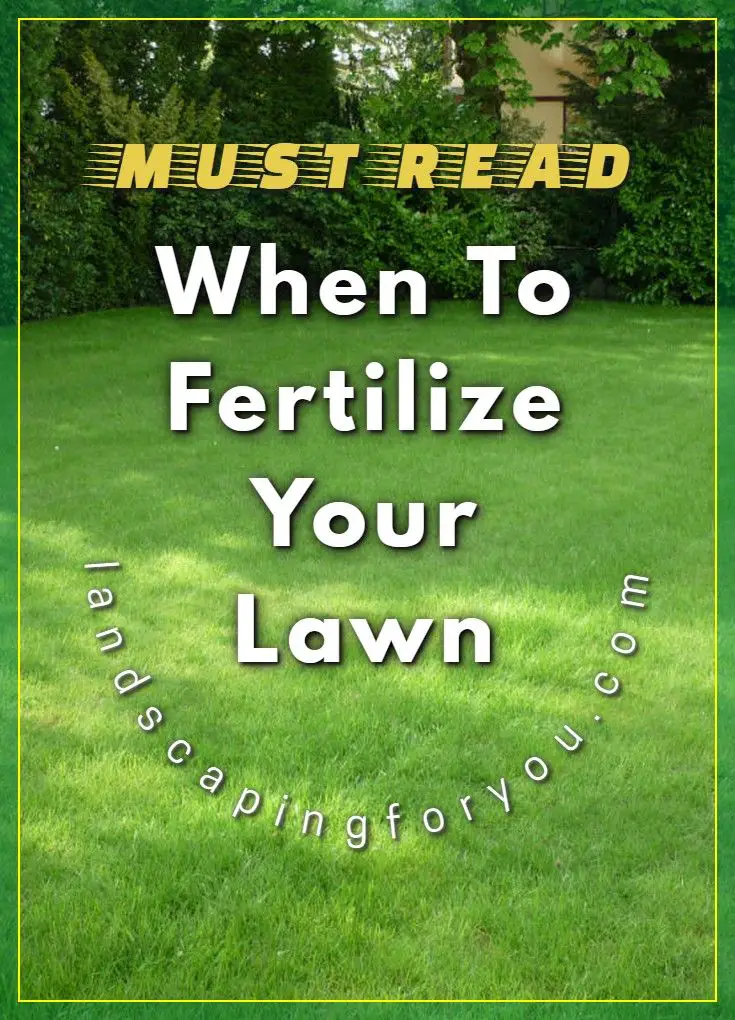Wait To Fertilize Your Lawn
El inglés es el idioma de control de esta página. En la medida en que haya algún conflicto entre la traducción al inglés y la traducción, el inglés prevalece.
Al hacer clic en el enlace de traducción se activa un servicio de traducción gratuito para convertir la página al español. Al igual que con cualquier traducción por Internet, la conversión no es sensible al contexto y puede que no traduzca el texto en su significado original. NC State Extension no garantiza la exactitud del texto traducido. Por favor, tenga en cuenta que algunas aplicaciones y/o servicios pueden no funcionar como se espera cuando se traducen.
English is the controlling language of this page. To the extent there is any conflict between the English text and the translation, English controls.
Dont let an unseasonably warm day fool you into fertilizing your lawn. The timing, nutrient ratio and amount of lawn fertilizer depends on the variety of grass youre working with but generally, fertilize when grass is actively growing. Although one type doesnt fit all situations, here in the eastern piedmont we have success with both warm and cool-season grass varieties that are adapted to our location. Getting the perfect lawn depends on what your needs are for use, looks, wear and tear as well as available resources of time and money. Proper fertilization is certainly a part of putting together a workable plan.
Saturday, February 10 from 10-11 a.m.
Best Fall Lawn Fertilizer
A fertilizer with a formula of 20-8-8 will get it growing again. Always follow the manufacturer’s recommended rate of application. Some people treat weeds and insects at this time, but I think that unless there are signs of trouble or a history of problems, don’t apply anything but fertilizer.
While this fall lawn fertilizer dose is important, an application at the end of October or early November is essential. At that time, apply a fertilizer with a formula of 13-25-12. The push of phosphorus will stimulate root growth through November and even into early December. By helping roots grow before winter sets in, you are insuring that the lawn will green-up quicker in the spring and become more resistant to disease and draught.
Fertilizing After Seeding Or Overseeding
Fertilizing seeded areas should be avoided until the grass is well established. Many fertilizers contain a herbicide that keeps seed from germinating, and you wont be doing your new seed any favors by attempting to feed it so early on.
Once seed has become established, fertilizing is important to help get grass the nutrients it needs to get deep healthy root. But even so, do not fertilize until at least 4 weeks after germination to ensure all seed has taken root. And be sure to use a lower nitrogen feed for the first few applications so as to not give the weeds in the area a chance to choke out your newly forming grass roots. Instead, apply a general balanced fertilizer.
Also Check: How Much Peat Moss For Lawn
Rotary Spreader With Fertilizer
Tip: Before filling the hopper of a rotary spreader, make sure its closed. Also, consider filling the hopper over a tarp so you can easily gather any spilled fertilizer.
Scripps Networks, LLC
Tip: Before filling the hopper of a rotary spreader, make sure its closed. Also, consider filling the hopper over a tarp so you can easily gather any spilled fertilizer.
Nitrogen is every lawn’s most important ingredient, and each type of grass demands different amounts to display peak growth and performance. How often you fertilize affects not only lawn appearance, but also maintenance level. The more you fertilize, the more you’ll have to mow, for instance.
More: How to Choose the Right Fertilizer
What Happens If I Over

Along with fertilize burn, over-fertilizing can cause damage to your turfs root structure, as well. Some fertilizers contain high levels of nitrogen, which if absorbed in large amounts can become harmful. What mainly causes the dreaded burn, however, is an abundant accumulation of soluble salts.
Recommended Reading: Fix Dead Grass Patches
Fertilize Turf To Help Heal Damaged Lawns
Damaged areas in turf will recover more quickly with two applications of fertilizer in the fall. The first application should be made in early fall . This will help turf recover from damage that occurred during the growing season. Nitrogen and potash stimulate turf growth and repair, and harden off the turf for winter. Fertilizer should be applied at a rate to deliver 0.5 kg of nitrogen per 100 m2.
What To Do After Your First Use Of Lawn Fertilizer
After you apply fertilizers, keep these tips in mind.
- Dont use the lawn for at least 24 hours. Keep pets and children away from the grass until its completely dry and the soil has absorbed the fertilizers.
- Dont mow for 48 hours. Avoid mowing the lawn for the first couple of days after fertilizing, because it can move the fertilizer around before its set.
You May Like: How To Clean Push Mower Carburetor
When To Fertilize Cool Season Grasses
Cool season grasses, as expected, grow in cooler climates. They stay mostly green year round where they have cold winters, and cool summers. Growing seasons that average between 60-75 degrees that include cold winter months are ideal. Many lawn owners ask when to apply winter lawn fertilizer, but for winter lawns you will want to fertilize in fall.
These grasses include:
Fertilizing cool season grasses should occur three times a year, twice in the fall, and once in the spring. Fall feeding is the most important time to fertilize, and should occur about six weeks before the first frost. Generally early to mid September is a good time to consider in order to let grass roots take in the extra nutrients as they ready to slow their growth for the winter, and again after frost, usually sometime in November to help with winter feeding. Come spring you can also spread fertilizer lightly again after the first flush of growth occurs to avoid overfeeding, which can result in excessive top growth and shallower roots. .
After Your First Lawn Fertilizer Application
So now you know about the first treatment, but are wondering how often to fertilize lawn areas throughout the rest of the year?
After your first application, you want to apply another round of fertilizer 6 to 8 weeks later and repeat that two more times with 6 to 8 weeks in between.
Try to schedule your applications so you apply ahead of the hottest part of summer to give your lawn the necessary boost.
For an established lawn, youll fertilize 4 times each season, though that is based on some important assumptions. If your grass is damaged and youre growing it fresh, your lawn will require more treatments until its established.
This is also true if your lawn has a species of grass that isnt native to your climate, like in areas that are more hostile to grasses. Alternatively, the opposite is also true. Fertilizing regularly is most necessary when trying to keep alive grasses that arent native to your area.
Its very likely you can get away with only fertilizing 1 to 2 times per year if the grass in your lawn is native. A healthy lawn can get by with fertilizing in the spring, and maybe again In the fall to keep it strong through the off-season.
You May Like: American Made Riding Lawn Mower
Apply Lawn Fertilizer With Care
Grass will benefit the most from lawn fertilizer when it’s applied correctly. First, do not fertilize right after you mow wait at least two days after mowing. Second, use a spreader to apply it evenly and make sure it reaches all areas of your yard. Close the spreader hopper when stopping and turning so fertilizer doesn’t leak out in piles. Clean sidewalks and paths of any excess fertilizer to prevent it from washing or blowing into grass, resulting in burn spots.
The best time to apply your lawn fertilizer is in the morning when the grass is wet with dew, and you’re not expected to have rain for one or two days. Once you apply the lawn fertilizer, add at least a half inch of water within 14 days per Pennington Seed. This can be from rainfall or watering with a sprinkler.
Feeding your grass a regular dose of lawn fertilizer helps it stay healthy, strong and green all summer long so you can enjoy it as much as possible.
References
Of Overseeding Or Reseeding
Managing a beautiful lawn, there is a secret behind it, that is known by the professionals, not by the lawn owners most of the cases. Lawn Owners are not used to overseeding to make their lawn impressive as part of the lawn care plan. Only experienced persons can get the perfect result by reflecting their methods on that work.
The fundamental method is the same everywhere but depends on the geographical places and the varieties/type of grass and its growth systems. Soil compaction and soil temperatures are also deciding factors.
Read Also: How Much To Aerate Lawn
Is It Too Late To Fertilize In The Summer
At this point you should be mowing your lawn, as grass should be actively growing during this time of the year. When it gets to the peak of summer, it is too hot to put down fertilizer. Putting down fertilizer at the peak of summer can cause damage to your lawn, but there are other ways you can add nutrients to your lawn during the high temperatures. Grasscycling is a free and easy way to feed your lawn. Grasscycling is when you leave the grass clippings on your lawn after mowing, the grass clippings will decompose and naturally fertilize your lawn. Remember to cut your grass at 3 to 4 inches to keep the roots shaded and allow for maximum water retention. Water your lawn and keep your grass happy to avoid summer lawn stress and damage. If you are facing extreme heat during the summer, which does happen in Ohio, water strategically for extreme heat and keep the nutrients in your grass and soil.
When Is Fertilization Done

Giving your soil the proper nutrients is essential for maintaining your lawns health. When you realize that your soil type cant provide all the nutrients your lawn needs, thats when you should begin the fertilization process. In this way, we will achieve proper growth and development, producing completely healthy leaves.
However, the fertilization process is not simple, and it varies depending on the type of soil, type of grass, fertilizer, and season of the year. For this reason, it is advisable to leave this procedure to the experts.
Recommended Reading: Does Lowes Rent Riding Lawn Mowers
Apply Lawn Fertilizer In Spring
Deciding exactly when to apply lawn fertilizer depends on where you live. According to Scotts, you should apply lawn fertilizer between February and April when your grass starts to green up and begins to actively grow. Essentially, if it looks like your grass is ready for its first mowing of the season, then it’s ready for lawn fertilizer.
Giving your grass a good dose of lawn fertilizer in the spring sets the stage for a healthy growing season. It strengthens the roots and gives the grass a boost of nutrients to sustain it as it grows. The type of fertilizer you need depends on what type of grass you have and if you want to address other problems, such as weed prevention, or kill pests, like fire ants.
If you’re not sure what type of fertilizer to use, you can speak with your local garden center expert to find out what works best for your grass. Are you not sure what type of grass you have? Cut a small sample and take it with you to show the garden center expert.
When To Fertilize Lawn
Knowing when to fertilize your lawn depends on how often you plan to apply it. If you fertilize once a year, do it around Labor Day thats when lawns absorb the most nutrients. For biannual fertilizing, add a second application the middle of October.
There are exceptions to this timeline depending on climate and soil types, so adjust if your lawn is not retaining enough nutrients. In the spring, if you feel the need, spread a little fertilizer to help the greening process.
Recommended Reading: What Is The Best Cordless Lawn Edger
Should You Fertilize Before Or After Rain
Does it matter if you fertilize before a heavy rain? Yes, it does. This is not a good time to apply fertilizer because a heavy rainfall could wash away the fertilizer before it has an opportunity to break down and be absorbed. This is especially true on steep slopes. If you would rather not waste your time and the money youve invested, its best to fertilize when no rainfall is expected for two days, or spread the fertilizer before it rains if youre anticipating only light rainfall. The light rainfall can substitute for watering in the fertilizer after application.
Seasonal Plant Growth Cycle
In early spring, roots are long and full of nutrients stored from the fall. Shoots, the part of grass visible above ground, use this stored energy for growth.
In warm summer temperatures, leaf and root growth slow down. Plants rest during times of heat and drought. Roots can be damaged when soil temperatures are above 85°F.
In the fall months shoots start to grow again and nutrients are stored in the long roots for the winter. Optimal shoot growth occurs with air temperatures of 55 to 75°F.
Cool-season root growth is stimulated by soil temperatures above 32°F, and is optimal with soil temperatures between 50 and 65°F.
You May Like: Can Geese Smell
Choose The Right Fertilizer For A Greener Spring Lawn
The Spruce
Keep your lawn or garden healthy before it goes into a period of winter dormancy with an application of fertilizer in the late fall. This is the time when cool-season grasses recover from summer stresses, such as drought, heat, and disease and turfgrass can begin to store carbohydrate reserves in the stems, rhizomes, and stolons. These carbohydrate reserves help grass resist winter injury and disease, as well as serve as a source of energy for root and shoot growth the following spring. Late-fall fertilization will also provide better winter color, enhanced spring green-up, and increased rooting. Additionally, a mild feeding of ornamental garden beds or vegetable gardens can also replenish soil that has been heavily depleted by growing plants over the season.
When To Fertilize Cool
Fertilize cool-season grasses in early fall. These fertilizers are often sold under the moniker “winterizer fertilizer.” Many lawn care professionals state that cool-season grasses can get by with just one fertilizer application per year in the fall. The fall feeding is responsible for a quick green-up in spring. For most regions where cool-season grasses grow, apply fertilizer in October or November. Make applications before grass starts to discolor with the arrival of cold weather. Check with your local extension office or a reputable garden center to discover the proper timing for your region.
Cool-season grass types include fescue, bluegrass and perennial ryegrass. Cool season grasses grow best at temps of 60 degrees to 75 degrees in areas with cold winters .
You May Like: How To Estimate Lawn Mowing Jobs
How Often To Fertilize Lawn
Over-fertilizing is a thing. If once a year is right for your lawn, stick with that and dont get carried away. Fertilizer can be a valuable tool to keep a lawn healthy, dense and looking great, but it can also create environmental concerns if not used responsibly. Follow the label instructions on your fertilizer as each product has unique specifications and needs.
Calculate Your Lawn Space

- First, you must determine how much fertilizer you need to properly feed your lawn. To do this, you’ll need to calculate the square footage of your lawn space. You dont need to measure areas without grass, such as flower beds and walkways. A measuring wheel makes measuring your lawn easier.
- If your lawn is rectangular, multiply the length and width to get the total square footage. If you have an irregularly shaped lawn, or one containing a lot of islands, divide the space into rectangular sections. Multiply the length and width of each section, then add up the sums to get the total square footage.
Read Also: How To Fix Dead Grass Patches On Lawn
Understand Fertilizer And Its Role As Plant Food
Before spreading the fertilizer on your lawn, its important to understand what youre doing. The reason why its essential is because not all fertilizer is the same.
This is why its not a good idea to just pick out the cheapest bag in the store or get something that fits your budget. If you do this, you may end up with fertilizer that doesnt help your garden grow. The problem with this is that you wont know what went wrong.
So, to start from the beginning, plants need certain factors to grow. These include sunlight, water, soil and fertilizer. Technically, fertilizer is just a booster. It basically contains a bit more of the nutrients found in soil.
So what are these elements? The most important are nitrogen, phosphorus and potassium. Youll see these elements in your fertilizer bags labeled as N, P and K. In addition, there are other elements included in smaller amounts. But, the three are the main ingredients.
The reason these three are the most important is that plants need a lot of them to grow. Your task is to figure out the composition and balance of these nutrients thats ideal for your lawn.
